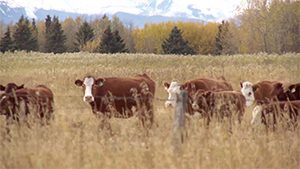Why a Cost of Production Network?
This is Part One of a three-part series (watch for Part Two and Part Three in the coming weeks).
Editor’s note: this article is also available in French. Download the translated version here.

Canada is the sixth largest beef exporter in the world. Live cattle to the United States are also a substantial business. Cost of production and price competitiveness are key aspects to any major exporting commodity, along with regulatory environment and available resources. The beef industry must be profitable and competitive to secure land, labour, and capital otherwise those investments will go into other commodities that provide a greater return on investment.The Canadian Cow-Calf Cost of Production Network (CDN COP Network) has been developed collaboratively with provincial coordinators and funded by the Beef Cattle Research Council. Industry has taken a lead role in coordinating the Network working with local expertise in each province. This information will support cow-calf producers as they evaluate how to evolve with new technologies and enhance competitiveness in an international marketplace.
The four reasons for creating the CDN COP Network are:
- Benchmarks created for specific ecoregions and production systems
- National coverage and standardized methodology
- Reduced response burden
- Learning in community
Benchmarks Created for Specific Ecoregions and Production Systems
Producers use cost of production data to benchmark and evaluate their own farm’s performance over time, but also to benchmark against a provincial average to determine competitiveness and resilience. However, provincial averages mean that data from an operation in one region of a province with less than 100 days of winter feeding and an operation located in an area with over 150 days of winter feeding are aggregated together into a single benchmark. These “benchmarks” do not make sense to producers and discourage participation in these programs and the concept of benchmarking.
Grouping farms together based upon production practices rather than using provincial boundaries will allow producers to self-select benchmark farms that they can identify with through a set of management practices that best fit their operation’s situation.
Table 1. Example of Different Production Systems
| Production System A | Production System B | |
|---|---|---|
| Calving start date | January 15 | April 15 |
| Calving season length | 63 days | 90 days |
| Weaning dates | October 15-30 | November 1-15 |
| Retained ownership | Replacements only | Pre-condition calves before sale |
| % of Land base used for cash crops | 0% | 50% |
| Days of fall grazing (e.g. swath-grazing, crop residue, corn grazing) | 30 | 45 |
| Winter feeding location | Confined | Extensive (in-field) |
| First day of winter feeding | October 25 | December 30 |
| Days supplemented (e.g. hay) while on pasture, feed brought in. | 0 | 120 |
| Days on full feed (unable to graze) | 150 | 0 |
National Coverage and Standardized Methodology
There has been limited cost of production data available to cow-calf producers outside of Alberta for several years. Historically each province has had their own system for collecting and calculating cost of production. Differences in methodology has meant results could not be compared, or if they were, it was done with caveats that methodology differed. Over the last 20 years, investment by provinces has declined from annual on-farm collection to surveys every five years, or no collection at all in some areas.
With the CDN COP Network, there will be cost of production benchmarking data from coast to coast for the first time, all utilizing a standardized methodology that allows for international comparisons in agri benchmark, an international cost of production network with coverage in 34 countries representing 80% of global beef production.
Reducing Response Burden
Producer data will be collected every five years with prices indexed annually. This means that historical data will be available right away for analysis and research projects. Data collection through the CDN COP Network provides the basis for the different types of production systems in each region, while provincial averages will be used for the appropriate sale weeks and weights for each animal type annually.
In addition, duplication will be minimized as this cost of production information is used in research projects, reducing the need for additional data collection from producers. Specifically, the CDN COP Network data will provide the basis for the Canadian Roundtable for Sustainable Beef’s updated economic assessment in 2021-2023. This project will connect cow-calf economics with practices that reduce greenhouse gas emissions on-farm to find win-win solutions.
Learning in Community
Producers are able to learn from each other and share ideas on how to implement different practices once they complete their participation in a focus group (stay tuned for Part three: A New Approach to Cost of Production Benchmarking). The goal of the Network is not just to provide benchmarks, but also to encourage innovation and pass on knowledge to a new generation of producers entering the industry and learn from other producers.
This is an opportunity to be a part of a producer network committed to learning about the benefits and costs of adopting different practices and improving together. Scenarios will be developed for what future farms could look like utilizing the 5% Rule to identify where incremental improvements could be made around productivity, input costs, and output prices.
How to Participate?
Go to www.canfax.ca/COPNetwork.aspx and fill out the Producer Sign-up Survey.
NEXT IN THE SERIES: Networks Make the Dream Work
Click here to subscribe to the BCRC Blog and receive email notifications when new content is posted.
The sharing or reprinting of BCRC Blog articles is welcome and encouraged. Please provide acknowledgement to the Beef Cattle Research Council, list the website address, www.BeefResearch.ca, and let us know you chose to share the article by emailing us at [email protected].
We welcome your questions, comments and suggestions. Contact us directly or generate public discussion by posting your thoughts below.